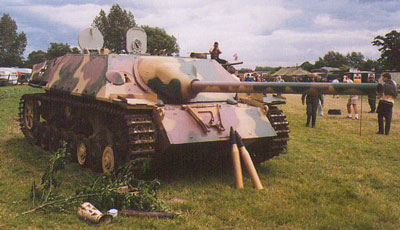
Logo from Scott Cunningham.

Logo from Scott Cunningham.
![]() olled homogenous armour (RHA) is essentially cast metal which has been further worked and shaped, aligning the grain structure of the metal and thus increasing its ballistic strength. It is made by first pouring molten metal into moulds and allowing it to cool and solidify into ingots. These big barrel shaped pieces which come out of the moulds are pounded with giant hammers to form billets which are then rolled at the rolling mill to become slabs. The rolling mill uses tonnes of pressure on a wide roller above and another below the red hot steel slab. The slab is rolled many times, in at least two perpendicular directions (cross-rolling), until the desired thickness is achieved.1
olled homogenous armour (RHA) is essentially cast metal which has been further worked and shaped, aligning the grain structure of the metal and thus increasing its ballistic strength. It is made by first pouring molten metal into moulds and allowing it to cool and solidify into ingots. These big barrel shaped pieces which come out of the moulds are pounded with giant hammers to form billets which are then rolled at the rolling mill to become slabs. The rolling mill uses tonnes of pressure on a wide roller above and another below the red hot steel slab. The slab is rolled many times, in at least two perpendicular directions (cross-rolling), until the desired thickness is achieved.1
The steel must then be hardened. It is re-heated to the transformation temperature (above 800°C) and plunged in water or oil. The rapid cooling works crystalline changes so that the steel becomes very hard, providing the alloy content is correct; the steel transforms from its high temperature crystal structure (called “austenite”) into a harder structure (called “martensite”) that is different from the normal room temperature crystal structure.2 It is then reheated to just below the transformation temperature and cooled again. This last step is called tempering and reduces the hardness while greatly increasing the ductility. The steel is now called rolled and homogeneous, that is, it has been shaped by rolling and the molecular structure is generally uniform throughout the cross section.1

A Jagd.Pz.IV/70(V) showing the slab armour plates characteristic of RHA. Only the mantlet is curved, indicating it is a cast piece. From Armour in Focus.
The RHA plates used in World War I were relatively thin (8–14mm) and very hard with a BHN of 420 to as much as 650. As plates became thicker and were joined by welding instead being riveted to a frame the armour had to become less hard. So from the 1930s armour plates became generally of machineable quality steel with a BHN ranging from about 390 for thin plates down to 220 for very thick plates.3
Relatively thin plates with a BHN of only 260 are used for belly armour, which has to withstand mine blast instead of attack by projectiles and therefore needs to be tough rather than hard.3
Do you like this web site? Please rate it between one and ten, with ten being the best:
Ratings are submitted to: The Wargames and Military History Search Engine.
Copyright © 2000 David Michael Honner. E-mail: GvA@wargamer.org.